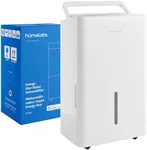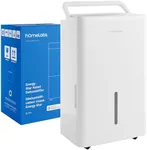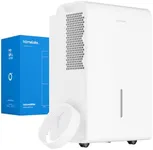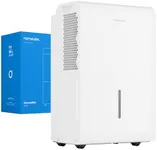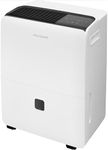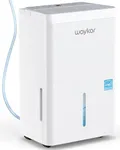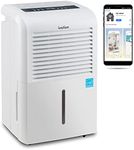Buying Guide for the Best Basement Dehumidifiers
Choosing the right basement dehumidifier is important if you want to keep your space dry, comfortable, and free of mold or musty odors. Basements are naturally prone to high humidity, and a good dehumidifier helps control moisture, making your home healthier and protecting your belongings from damage. When picking a dehumidifier, focus on how much moisture it can remove, how big your space is, and how easy the unit is to use and maintain. Think about the specific problems in your basement—like persistent dampness, occasional musty smells, or water after heavy rain—to guide your decision.Capacity (Pint Removal per Day)Capacity tells you how much water a dehumidifier can remove from the air in a 24-hour period, measured in pints or liters. This is crucial because if you pick a model that's too small, it won't keep up with the humidity in your basement, but if it's too large, you might use more energy than needed. Light dampness in small basements might only require a low-capacity (smaller pint) unit, while very wet or large basements need a high-capacity dehumidifier. Estimate the dampness and size of your basement: a small, slightly damp area needs less pints per day, but a large, constantly wet basement means you should look for higher daily removal rates.
Coverage Area (Square Feet)Coverage area, usually measured in square feet or square meters, tells you the largest space a dehumidifier can handle effectively. This spec is important because using a unit that’s too weak for your space means it won't reduce humidity well, while using a much bigger one won't be efficient. Measure your basement’s size, and match the unit’s suggested coverage to your space. If your basement is an odd shape or connected to other rooms, consider that larger or open spaces might need a more powerful model.
Drainage OptionsDrainage options describe how the dehumidifier gets rid of the water it collects. This matters because manually emptying a tank can be a hassle, especially in high-humidity basements or if you’re away frequently. Basic models use a bucket that you empty, while others can be set up with a hose to drain continuously—sometimes using a pump if the drain is above the unit. For convenience and less maintenance, continuous drainage is ideal, but you’ll need a nearby drain or sink. Choose the system that fits your routine and basement setup best.
Operating Temperature RangeThis spec tells you the conditions in which the dehumidifier works best, especially in cooler basements. Some dehumidifiers struggle in cold spaces and can freeze up, while others are designed to run efficiently at lower temperatures. If your basement is chilly—especially unheated during winter—look for a model rated for low-temperature operation. This ensures reliable performance and avoids breakdowns in cold environments.
Noise LevelNoise level indicates how loud the dehumidifier is when it's operating, often measured in decibels. Basements used for storage aren’t usually sensitive to noise, but if your basement is finished or used as a living or work area, a quieter model is more comfortable. If noise could bother you, compare decibel ratings or look for user reviews mentioning sound. Decide how much noise you can tolerate based on how you use the space.
Energy EfficiencyEnergy efficiency measures how much electricity the dehumidifier uses to remove a certain amount of moisture. This matters because running a dehumidifier for long periods can increase your electricity bills. Look for models with energy-saving ratings or certifications, which mean they do the job using less power. If your dehumidifier will run constantly, prioritizing efficiency can save money and be more environmentally friendly.
Filter Type and MaintenanceMost dehumidifiers have filters to trap dust and allergens, improving air quality and protecting the unit’s parts. This is important for both clean air and reducing wear and tear. Filters need to be cleaned or replaced regularly—easier access and reusable filters mean less effort on your part. If you or your family have allergies or want to avoid frequent maintenance, check how easy the filter is to access and how often it needs attention.

